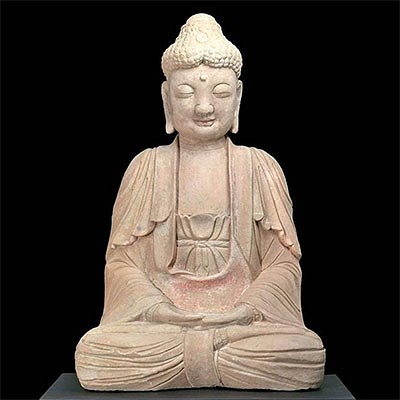Japanese Jomon Pottery Flame-Rimmed Cooking Vessel w/TL
Lot 75
About Seller
Artemis Gallery
686 S Taylor Ave, Ste 106
Louisville, CO 80027
United States
Selling antiquities, ancient and ethnographic art online since 1993, Artemis Gallery specializes in Classical Antiquities (Egyptian, Greek, Roman, Near Eastern), Asian, Pre-Columbian, African / Tribal / Oceanographic art. Our extensive inventory includes pottery, stone, metal, wood, glass and textil...Read more
Categories
Estimate:
$4,500 - $6,000
Absentee vs Live bid
Two ways to bid:
- Leave a max absentee bid and the platform will bid on your behalf up to your maximum bid during the live auction.
- Bid live during the auction and your bids will be submitted real-time to the auctioneer.
Bid Increments
| Price | Bid Increment |
|---|---|
| $0 | $25 |
| $300 | $50 |
| $1,000 | $100 |
| $2,000 | $250 |
| $5,000 | $500 |
| $10,000 | $1,000 |
| $20,000 | $2,500 |
| $50,000 | $5,000 |
| $100,000 | $10,000 |
| $200,000 | $20,000 |
About Auction
By Artemis Gallery
Feb 18, 2021
Set Reminder
2021-02-18 10:00:00
2021-02-18 10:00:00
America/New_York
Bidsquare
Bidsquare : Exceptional Antiquities, Asian, Ethnographic
https://www.bidsquare.com/auctions/artemis-gallery/exceptional-antiquities-asian-ethnographic-6373
Museum-worthy examples of Egyptian, Greek, Roman, Etruscan, Near Eastern, Far East / Asian, Pre-Columbian, African / Tribal, Oceanic, Native American, Spanish Colonial, Russian, Fossils, Ancient Jewelry, Fine Art, so much more! Artemis Gallery info@artemisgallery.com
Museum-worthy examples of Egyptian, Greek, Roman, Etruscan, Near Eastern, Far East / Asian, Pre-Columbian, African / Tribal, Oceanic, Native American, Spanish Colonial, Russian, Fossils, Ancient Jewelry, Fine Art, so much more! Artemis Gallery info@artemisgallery.com
- Lot Description
East Asia, Japan, Middle Jomon period, ca. 2500 BCE to 1500 BCE. A magnificent coil-formed "flame-rimmed" cooking vessel, known as a Kaen Doki fukabachi, displaying a round base, a long body that bulges near the base and then is corseted near the its broad top, and an extravagantly embellished, circular rim. Decorated by pressing a cord onto the wet clay before firing, the ancient vessel boasts a gorgeous motif of diagonal and curvilinear striations along is elongated body. Its unique rim is adorned with a large swirling embellishment consisting of two openwork circles that serve as a type of spout flanked by a pair of triangular adornments that can be used as handles. With glistening specks from mica deposits shimmering throughout the surface, this example is a stunning combination of form and function from ancient Japan! Size: 13" in diameter x 17" H (33 cm x 43.2 cm)
The ancient Japanese Jomon Period is known for its distinctive pottery tradition that set it apart from the Paleolithic Age. Jomon pottery vessels are among the oldest in the world and typically present rope- or cord-like impressed decoration. In fact, the etymology of the word Jomon means cord pattern. Since no kilns have been excavated from the Jomon period, it is believed that the ancients fired these vessels in open fires.
According to the Metropolitan Museum of Art's Heilbrunn Timeline essay, "All Jomon pots were made by hand, without the aid of a wheel, the potter building up the vessel from the bottom with coil upon coil of soft clay. As in all other Neolithic cultures, women produced these early potteries. The clay was mixed with a variety of adhesive materials, including mica, lead, fibers, and crushed shells. After the vessel was formed, tools were employed to smooth both the outer and interior surfaces. When completely dry, it was fired in an outdoor bonfire at a temperature of no more than about 900 C."
This piece has been tested using thermoluminescence (TL) analysis and has been found to be ancient and of the period stated. A full report will accompany purchase.
Provenance: ex-private Gold Coast, Chicago, Illinois, USA family collection, acquired 1950s to 1960s
All items legal to buy/sell under U.S. Statute covering cultural patrimony Code 2600, CHAPTER 14, and are guaranteed to be as described or your money back.
A Certificate of Authenticity will accompany all winning bids.
We ship worldwide and handle all shipping in-house for your convenience.
#161294Repaired from several pieces with break lines barely visible in most areas. Expected surface wear with light softening of detail, nicks/chips, and abrasions, all commensurate with age. Char marks due to use. Otherwise, excellent with lovely earthen deposits throughout.Condition
- Shipping Info
-
All shipping is handled in-house for your convenience. Your invoice from Artemis Gallery will include shipping calculation instructions. If in doubt, please inquire BEFORE bidding for estimated shipping costs for individual items.
-
- Buyer's Premium



 EUR
EUR CAD
CAD AUD
AUD GBP
GBP MXN
MXN HKD
HKD CNY
CNY MYR
MYR SEK
SEK SGD
SGD CHF
CHF THB
THB














